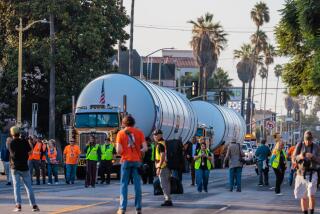Spacewalking Astronauts Add Antennas to Station
- Share via
HOUSTON — Two astronauts ventured out on another spacewalk Wednesday and installed antennas on the international space station that is under construction nearly 250 miles above Earth.
For the second time this week, Jerry Ross and James Newman floated out the hatch of the shuttle Endeavour to work on the seven-story, 35-ton station taking shape in the open cargo bay.
Their priority was to attach two 100-pound antennas to Unity, the American-made side of the station. Their other job, time permitting, was trickier: trying to open a stuck antenna on Zarya, the Russian-built control module.
The planned seven-hour spacewalk was not nearly as difficult or crucial as Monday night’s outing, during which Ross and Newman hooked up 40 electrical connections between Zarya and Unity.
It was a struggle, though, to get the suitcase-size antennas out of the narrow tunnel leading into the cargo bay. The spacewalkers had to back out of the tunnel feet first with the bulky, swinging antennas in tow.
The astronauts hoisted the antennas halfway up the 36-foot Unity on the end of the shuttle robot arm. Then they mounted the units on opposite sides of the cylinder, where just an hour earlier they had routed a communication cable.
The aluminum cylinder gleamed in the sunlight, its “Unity” emblem clearly visible.
Once activated, the antennas will provide a direct, virtually uninterrupted communication link between Unity and NASA’s Mission Control. Otherwise, U.S. flight controllers would have to rely on the sporadic coverage provided by Russian ground stations.
The electronic and computer hookups for the antennas will be made inside Unity today, after the entire crew enters the orbiting station for the first time.
Other spacewalking chores for Ross and Newman on Wednesday evening included erecting a sunshade over a computer mounted to Unity’s exterior.
Flight controllers urged Newman to be cautious with the antenna. It was rolled up on a spool, and engineers worried that the 3-foot strip might pop open with enough force to hurt him if he got too close. Newman had a 10-foot grappling hook for the job.
The antenna is one of two that failed to open properly after Zarya’s Nov. 20 launch from Kazakstan.
More to Read
Sign up for Essential California
The most important California stories and recommendations in your inbox every morning.
You may occasionally receive promotional content from the Los Angeles Times.













